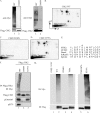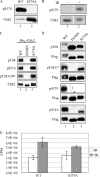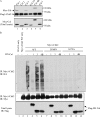Regulation of Chk2 ubiquitination and signaling through autophosphorylation of serine 379
- PMID: 18644861
- PMCID: PMC2547006
- DOI: 10.1128/MCB.00821-08
Regulation of Chk2 ubiquitination and signaling through autophosphorylation of serine 379
Abstract
The Chk2 protein kinase protects genome integrity by promoting cell cycle arrest or apoptosis in response to DNA double-strand breaks, and Chk2 mutations are found in both familial and sporadic cancers. Exposure of cells to ionizing radiation (IR) or radiomimetic drugs induces Chk2 phosphorylation by ATM, followed by Chk2 oligomerization, auto-/transphosphorylation, and activation. Here we demonstrate that Chk2 is ubiquitinated upon activation and that this requires Chk2 kinase activity. Serine 379 (S379) was identified as a novel IR-inducible autophosphorylation site required for ubiquitination of Chk2 by a Cullin 1-containing E3 ligase complex. Importantly, S379 was required for Chk2 to induce apoptosis in cells with DNA double-strand breaks. Thus, auto-/transphosphorylation of S379 is required for Chk2 ubiquitination and effector function.
Figures






References
-
- Abramoff, M. D., P. J. Magelhaes, and S. J. Ram. 2004. Image processing with Image J. Biophotonics Int. 1136-42.
-
- Ahn, J.-Y., X. Li, H. L. Davis, and C. E. Canman. 2002. Phosphorylation of threonine 68 promotes oligomerization and autophosphorylation of the Chk2 protein kinase via the Forkhead-associated (FHA) domain. J. Biol. Chem. 27719389-19395. - PubMed
-
- Ahn, J.-Y., J. K. Schwarz, H. Piwnica-Worms, and C. E. Canman. 2000. Threonine 68 phosphorylation by ataxia telangiectasia mutated is required for efficient activation of Chk2 in response to ionizing radiation. Cancer Res. 605934-5936. - PubMed
-
- Bartek, J., and J. Lukas. 2001. Pathways governing G1/S transition and their response to DNA damage. FEBS Lett. 490117-122. - PubMed
-
- Bartkova, J., J. Falck, E. Rajpert-De Meyts, N. E. Skakkebaek, J. Lukas, and J. Bartek. 2001. Chk2 tumour suppressor protein in human spermatogenesis and testicular germ-cell tumours. Oncogene 205897-5902. - PubMed
Publication types
MeSH terms
Substances
Grants and funding
LinkOut - more resources
Full Text Sources
Molecular Biology Databases
Research Materials
Miscellaneous
